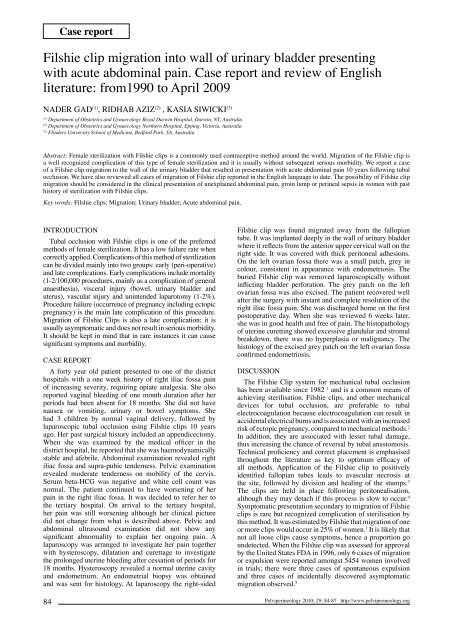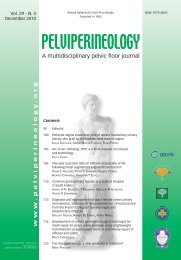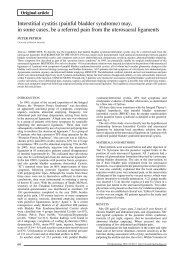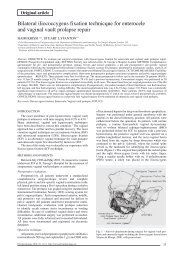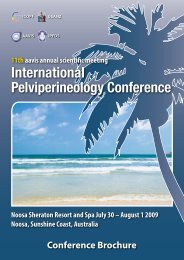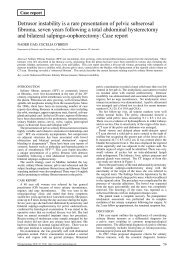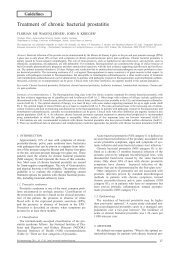Filshie clip migration into wall of urinary bladder ... - Pelviperineology
Filshie clip migration into wall of urinary bladder ... - Pelviperineology
Filshie clip migration into wall of urinary bladder ... - Pelviperineology
You also want an ePaper? Increase the reach of your titles
YUMPU automatically turns print PDFs into web optimized ePapers that Google loves.
Case report<br />
<strong>Filshie</strong> <strong>clip</strong> <strong>migration</strong> <strong>into</strong> <strong>wall</strong> <strong>of</strong> <strong>urinary</strong> <strong>bladder</strong> presenting<br />
with acute abdominal pain. Case report and review <strong>of</strong> English<br />
literature: from1990 to April 2009<br />
NADER GAD (1) , RIDHAB AZIZ (2) , KASIA SIWICKI (3)<br />
(1)<br />
Department <strong>of</strong> Obstetrics and Gynaecology Royal Darwin Hospital, Darwin, NT, Australia<br />
(2)<br />
Department <strong>of</strong> Obstetrics and Gynaecology Northern Hospital, Epping, Victoria, Australia<br />
(3)<br />
Flinders University School <strong>of</strong> Medicine, Bedford Park, SA, Australia<br />
Abstract: Female sterilization with <strong>Filshie</strong> <strong>clip</strong>s is a commonly used contraceptive method around the world. Migration <strong>of</strong> the <strong>Filshie</strong> <strong>clip</strong> is<br />
a well recognized complication <strong>of</strong> this type <strong>of</strong> female sterilization and it is usually without subsequent serious morbidity. We report a case<br />
<strong>of</strong> a <strong>Filshie</strong> <strong>clip</strong> <strong>migration</strong> to the <strong>wall</strong> <strong>of</strong> the <strong>urinary</strong> <strong>bladder</strong> that resulted in presentation with acute abdominal pain 10 years following tubal<br />
occlusion. We have also reviewed all cases <strong>of</strong> <strong>migration</strong> <strong>of</strong> <strong>Filshie</strong> <strong>clip</strong> reported in the English language to date. The possibility <strong>of</strong> <strong>Filshie</strong> <strong>clip</strong><br />
<strong>migration</strong> should be considered in the clinical presentation <strong>of</strong> unexplained abdominal pain, groin lump or perineal sepsis in women with past<br />
history <strong>of</strong> sterilization with <strong>Filshie</strong> <strong>clip</strong>s.<br />
Key words: <strong>Filshie</strong> <strong>clip</strong>s; Migration; Urinary <strong>bladder</strong>; Acute abdominal pain.<br />
Introduction<br />
Tubal occlusion with <strong>Filshie</strong> <strong>clip</strong>s is one <strong>of</strong> the preferred<br />
methods <strong>of</strong> female sterilization. It has a low failure rate when<br />
correctly applied. Complications <strong>of</strong> this method <strong>of</strong> sterilization<br />
can be divided mainly <strong>into</strong> two groups: early (peri-operative)<br />
and late complications. Early complications include mortality<br />
(1-2/100,000 procedures, mainly as a complication <strong>of</strong> general<br />
anaesthesia), visceral injury (bowel, <strong>urinary</strong> <strong>bladder</strong> and<br />
uterus), vascular injury and unintended laparotomy (1-2%).<br />
Procedure failure (occurrence <strong>of</strong> pregnancy including ectopic<br />
pregnancy) is the main late complication <strong>of</strong> this procedure.<br />
Migration <strong>of</strong> <strong>Filshie</strong> Clips is also a late complication; it is<br />
usually asymptomatic and does not result in serious morbidity.<br />
It should be kept in mind that in rare instances it can cause<br />
significant symptoms and morbidity.<br />
Case report<br />
A forty year old patient presented to one <strong>of</strong> the district<br />
hospitals with a one week history <strong>of</strong> right iliac fossa pain<br />
<strong>of</strong> increasing severity, requiring opiate analgesia. She also<br />
reported vaginal bleeding <strong>of</strong> one month duration after her<br />
periods had been absent for 18 months. She did not have<br />
nausea or vomiting, <strong>urinary</strong> or bowel symptoms. She<br />
had 3 children by normal vaginal delivery, followed by<br />
laparoscopic tubal occlusion using <strong>Filshie</strong> <strong>clip</strong>s 10 years<br />
ago. Her past surgical history included an appendicectomy.<br />
When she was examined by the medical <strong>of</strong>ficer in the<br />
district hospital, he reported that she was haemodynamically<br />
stable and afebrile. Abdominal examination revealed right<br />
iliac fossa and supra-pubic tenderness. Pelvic examination<br />
revealed moderate tenderness on mobility <strong>of</strong> the cervix.<br />
Serum beta-HCG was negative and white cell count was<br />
normal. The patient continued to have worsening <strong>of</strong> her<br />
pain in the right iliac fossa. It was decided to refer her to<br />
the tertiary hospital. On arrival to the tertiary hospital,<br />
her pain was still worsening although her clinical picture<br />
did not change from what is described above. Pelvic and<br />
abdominal ultrasound examination did not show any<br />
significant abnormality to explain her ongoing pain. A<br />
laparoscopy was arranged to investigate her pain together<br />
with hysteroscopy, dilatation and curettage to investigate<br />
the prolonged uterine bleeding after cessation <strong>of</strong> periods for<br />
18 months. Hysteroscopy revealed a normal uterine cavity<br />
and endometrium. An endometrial biopsy was obtained<br />
and was sent for histology. At laparoscopy the right-sided<br />
84<br />
<strong>Filshie</strong> <strong>clip</strong> was found migrated away from the fallopian<br />
tube. It was implanted deeply in the <strong>wall</strong> <strong>of</strong> <strong>urinary</strong> <strong>bladder</strong><br />
where it reflects from the anterior upper cervical <strong>wall</strong> on the<br />
right side. It was covered with thick peritoneal adhesions.<br />
On the left ovarian fossa there was a small patch, grey in<br />
colour, consistent in appearance with endometriosis. The<br />
buried <strong>Filshie</strong> <strong>clip</strong> was removed laparoscopically without<br />
inflicting <strong>bladder</strong> perforation. The grey patch on the left<br />
ovarian fossa was also excised. The patient recovered well<br />
after the surgery with instant and complete resolution <strong>of</strong> the<br />
right iliac fossa pain. She was discharged home on the first<br />
postoperative day. When she was reviewed 6 weeks later,<br />
she was in good health and free <strong>of</strong> pain. The histopathology<br />
<strong>of</strong> uterine curetting showed excessive glandular and stromal<br />
breakdown, there was no hyperplasia or malignancy. The<br />
histology <strong>of</strong> the excised grey patch on the left ovarian fossa<br />
confirmed endometriosis.<br />
Discussion<br />
The <strong>Filshie</strong> Clip system for mechanical tubal occlusion<br />
has been available since 1982 1 and is a common means <strong>of</strong><br />
achieving sterilisation. <strong>Filshie</strong> <strong>clip</strong>s, and other mechanical<br />
devices for tubal occlusion, are preferable to tubal<br />
electrocoagulation because electrocoagulation can result in<br />
accidental electrical burns and is associated with an increased<br />
risk <strong>of</strong> ectopic pregnancy, compared to mechanical methods. 2<br />
In addition, they are associated with lesser tubal damage,<br />
thus increasing the chance <strong>of</strong> reversal by tubal anastomosis.<br />
Technical pr<strong>of</strong>iciency and correct placement is emphasised<br />
throughout the literature as key to optimum efficacy <strong>of</strong><br />
all methods. Application <strong>of</strong> the <strong>Filshie</strong> <strong>clip</strong> to positively<br />
identified fallopian tubes leads to avascular necrosis at<br />
the site, followed by division and healing <strong>of</strong> the stumps. 3<br />
The <strong>clip</strong>s are held in place following peritonealisation,<br />
although they may detach if this process is slow to occur. 4<br />
Symptomatic presentation secondary to <strong>migration</strong> <strong>of</strong> <strong>Filshie</strong><br />
<strong>clip</strong>s is rare but recognized complication <strong>of</strong> sterilisation by<br />
this method. It was estimated by <strong>Filshie</strong> that <strong>migration</strong> <strong>of</strong> one<br />
or more <strong>clip</strong>s would occur in 25% <strong>of</strong> women. 1 It is likely that<br />
not all loose <strong>clip</strong>s cause symptoms, hence a proportion go<br />
undetected. When the <strong>Filshie</strong> <strong>clip</strong> was assessed for approval<br />
by the United States FDA in 1996, only 6 cases <strong>of</strong> <strong>migration</strong><br />
or expulsion were reported amongst 5454 women involved<br />
in trials; there were three cases <strong>of</strong> spontaneous expulsion<br />
and three cases <strong>of</strong> incidentally discovered asymptomatic<br />
<strong>migration</strong> observed. 5<br />
<strong>Pelviperineology</strong> 2010; 29: 84-87 http://www.pelviperineology.org
<strong>Filshie</strong> <strong>clip</strong> <strong>migration</strong><br />
Table 1. – Articles published (1997 – April 2009) <strong>of</strong> <strong>Filshie</strong> <strong>clip</strong> <strong>migration</strong> to the <strong>urinary</strong> <strong>bladder</strong> detailing clinical presentation, surgical notes,<br />
duration after application and means <strong>of</strong> removal <strong>of</strong> <strong>Filshie</strong> <strong>clip</strong>.<br />
Reference Presentation Pre-operative and<br />
operative conditions<br />
Duration after<br />
tubal<br />
occlusion<br />
Site <strong>of</strong> <strong>migration</strong><br />
Means <strong>of</strong> expulsion/<br />
extrusion/ removal<br />
Kesby and<br />
Korda (1997) 6<br />
24 hour history<br />
persistent macroscopic<br />
haematuria<br />
Uncomplicated<br />
procedure<br />
Nil post-op<br />
complications<br />
7 years Urinary <strong>bladder</strong> –deep<br />
bed <strong>of</strong> chronic mucosal<br />
ulceration on right side<br />
Spontaneous<br />
expulsion per urethra<br />
Nil pelvic pathology<br />
Miliauskas 2 week history pelvic<br />
(2003) 7 pain and haematuria<br />
Uncomplicated<br />
procedure<br />
2 years Urinary <strong>bladder</strong> - local<br />
abscess formation<br />
Surgical removal<br />
(partial cystectomy)<br />
Connolly<br />
et al. (2005) 8<br />
4 month history vague<br />
suprapubic discomfort,<br />
worse with menses<br />
Irritative <strong>bladder</strong><br />
symptoms: frequency,<br />
nocturia, urgency<br />
Palanivelu 1 year history <strong>of</strong><br />
and Lynch intermittent lower<br />
(2007) 10 abdominal pain &<br />
painful micturition<br />
Nil pelvic pathology<br />
Past history ovarian<br />
cystectomy<br />
Uncomplicated<br />
procedure<br />
Nil anatomic<br />
abnormalities<br />
Uncomplicated<br />
procedure<br />
10 years 9 Urinary <strong>bladder</strong> – nodule<br />
<strong>of</strong> chronically inflamed<br />
tissue on dome <strong>of</strong> <strong>bladder</strong><br />
Spontaneous<br />
expulsion per urethra<br />
(6 weeks after initial<br />
presentation)<br />
18 months Urinary <strong>bladder</strong> Spontaneous<br />
expulsion per urethra<br />
Case reports documented <strong>migration</strong> <strong>of</strong> <strong>clip</strong>s to the<br />
peritoneal cavity and specific organs, many with clinical<br />
presentations involving acute or chronic pain that mimicked<br />
common intra-abdominal pathologies (Table 1 and 2). Time to<br />
presentation varied greatly, from 6 weeks to approximately 20<br />
years following sterilisation. In the majority <strong>of</strong> cases, where<br />
reported during the tubal occlusion, pelvic anatomy was<br />
observed to be normal with absence <strong>of</strong> pelvic pathology. The<br />
procedure was reported to have been uncomplicated in most<br />
cases. Presumably, these favourable conditions facilitated<br />
identification <strong>of</strong> anatomical structures and correct placement<br />
<strong>of</strong> <strong>clip</strong>s. There was no apparent association between site <strong>of</strong><br />
<strong>migration</strong>, history <strong>of</strong> gynaecological procedures or pelvic<br />
pathology and duration to presentation.<br />
To date, <strong>migration</strong> to the <strong>urinary</strong> <strong>bladder</strong> has been reported<br />
in 4 other cases (Table 1). Additional sites <strong>of</strong> <strong>migration</strong> were<br />
the anterior abdominal <strong>wall</strong> (4), perianal/pararectal tissues<br />
(4), peritoneal cavity (3), groin (3), colon (2) and vagina (1)<br />
(Table 2). With the inclusion <strong>of</strong> this case, there were more<br />
reported cases <strong>of</strong> <strong>migration</strong> to the <strong>bladder</strong> than to other<br />
sites. Regarding <strong>migration</strong> to the <strong>bladder</strong>, the lack <strong>of</strong> <strong>urinary</strong><br />
symptoms in this case may be because the migrated <strong>Filshie</strong><br />
<strong>clip</strong> did not migrate through the full thickness <strong>of</strong> the <strong>bladder</strong><br />
<strong>wall</strong>.<br />
Abscess formation, ulceration, fistula formation, tissue<br />
induration and adhesion formation were commonly<br />
observed and suggest local tissue reaction to the <strong>Filshie</strong> <strong>clip</strong>.<br />
Resolution <strong>of</strong> symptoms following removal <strong>of</strong> migrated <strong>clip</strong>s,<br />
regardless <strong>of</strong> the means by which this occurred, supports the<br />
assumption that the pain and associated symptoms were due<br />
to a local inflammatory response.<br />
It is apparent that accurate documentation <strong>of</strong> anatomy,<br />
pelvic pathology and correct <strong>clip</strong> placement at the time<br />
<strong>of</strong> tubal occlusion can help in identifying long-term<br />
complications, but also preclude problems from a medicolegal<br />
perspective. It is reassuring that none <strong>of</strong> the reported<br />
cases <strong>of</strong> <strong>Filshie</strong> <strong>clip</strong> <strong>migration</strong> have resulted in mortality<br />
prior to their removal or chronic morbidity subsequent<br />
to their removal. Nevertheless, the clinical presentations<br />
necessitated radiological interventions and invasive surgery<br />
in most to identify and retrieve the <strong>clip</strong>(s). As such, the<br />
authors recommend that <strong>clip</strong> <strong>migration</strong> and its possible<br />
sequelae should be carefully explained to patients to ensure<br />
they are aware <strong>of</strong> this potential complication, that it may<br />
occur from weeks to years after occlusion and has varied<br />
presentations.<br />
Conclusion<br />
This case adds to the body <strong>of</strong> literature concerned with<br />
<strong>migration</strong> <strong>of</strong> <strong>Filshie</strong> <strong>clip</strong>s. Although rare, <strong>migration</strong> should<br />
be considered in the differential diagnosis <strong>of</strong> women<br />
experiencing abdomino-pelvic pain, without obvious<br />
pathology, who have previously undergone tubal occlusion<br />
by this method.<br />
References<br />
1. <strong>Filshie</strong> GM. Long-term experience with the <strong>Filshie</strong><strong>clip</strong>.<br />
Gynaecol Forum 2002; 7: 7-10.<br />
2. Peterson Hb, Xia Z, Hughes Jm, Wilcox Ls, Ratliff Taylor L,<br />
Trussell J. The risk <strong>of</strong><br />
ectopic pregnancy after tubal sterilization U.S. Collaborative<br />
Review <strong>of</strong> Sterilization Working Group. N Engl J Med 1997;<br />
336: 762-767.<br />
3. <strong>Filshie</strong> GM, Casey D, Pogmore JR, Dutton AG, Symonds<br />
EM, Peake AB. The titanium/silicone rubber <strong>clip</strong> for female<br />
sterilization. Br J Obstet Gynaecol 1981; 88: 655-62.<br />
4. Amu O, Husemeyer RP. Migration <strong>of</strong> sterilisation <strong>clip</strong>s: case<br />
report and review. Br J Fam Plann 1999; 25: 27-28.<br />
5. Obstetrics and Gynecology Devices Panel <strong>of</strong> the Department <strong>of</strong><br />
Health and Human Services Public Health Service, Food and<br />
Drug Administration meeting <strong>of</strong> February 26, 1996.<br />
6. Kesby GJ, Korda AR. Migration <strong>of</strong> <strong>Filshie</strong> <strong>clip</strong> <strong>into</strong> the <strong>urinary</strong><br />
<strong>bladder</strong> seven years after laparoscopic sterilisation. Br J Obstet<br />
Gynaecol 1997; 104: 379-382.<br />
7. Miliauskas JR. Migration <strong>of</strong> a <strong>Filshie</strong> <strong>clip</strong> <strong>into</strong> the <strong>urinary</strong><br />
<strong>bladder</strong> with abscess formation. Pathology. 2003; 35: 356-357.<br />
85
N. Gad - R. Aziz - K. Siwicki<br />
Table 2. – Articles published (1990 – April 2009) <strong>of</strong> <strong>migration</strong> <strong>of</strong> <strong>Filshie</strong> <strong>clip</strong>s to other organs excluding the <strong>urinary</strong> <strong>bladder</strong>. It shows patient<br />
main presentation, interval between <strong>clip</strong> application and organ from which <strong>Filshie</strong> <strong>clip</strong> was expelled or extruded.<br />
• Exact period not stated in source text, duration approximated from publication year and dates in text.<br />
Reference Presentation Pre-operative and operative<br />
conditions<br />
Duration<br />
after tubal<br />
occlusion<br />
Site <strong>of</strong> <strong>migration</strong><br />
Means <strong>of</strong> expulsion/<br />
extrusion/ removal<br />
Vagina Colon<br />
Groin<br />
Perianal/Pararectal tissues<br />
Anterior abdominal <strong>wall</strong><br />
Peritoneal cavity<br />
Daucher and<br />
Weber (2006) 11<br />
Diffuse mid-abdomen and<br />
RLQ pain<br />
Kalu et al. 1 year history LIF pain,<br />
(2006) 12 deep dyspareunia and<br />
dysuria<br />
Loddo et al. Nil symptoms<br />
(2008) 13 Removal requested for<br />
religions reasons<br />
Amu and 5 week history painful<br />
Husemeyer swelling around umbilicus<br />
(1999) 4<br />
Lok et al. 3 day history painful lump<br />
(2003) 14 below umbilicus<br />
Krishnamoorthy<br />
et al. (2004) 15<br />
3 months later, pain and<br />
purulent discharge from<br />
abscess formed whilst<br />
waiting for elective surgery<br />
3 week history increasing<br />
pain over abdominal lump<br />
3 day history greenish<br />
discharge from lump<br />
Tan et al. Yellowish vaginal<br />
(2004) 16 discharge 6 weeks post<br />
partum<br />
LIF pain from 6 weeks post<br />
partum<br />
Left-sided premenstrual<br />
pain at 2 years post-partum<br />
Pandit (2004) 17 Passage <strong>of</strong> <strong>Filshie</strong> <strong>clip</strong><br />
rectally<br />
Hasan et al. Vague lower abdominal<br />
(2005) 18 pain and loose motions<br />
(2001)<br />
Recurrent perianal abscess<br />
(2004)<br />
Buczacki et al. 5 month history<br />
(2007) 19 discharging lesion around<br />
anus (apparent fistula in<br />
ano)<br />
Dua and 4 month history recurrent<br />
Dworkin peri-anal abscess with<br />
(2007) 20 fistula formation<br />
Bleeding from fistula at<br />
menses<br />
Garner et al. 3 day history <strong>of</strong> lump in<br />
(1998) 21 right groin<br />
Khalil and<br />
Reddy (2006) 22<br />
2 week history irreducible,<br />
tender right groin lump<br />
Verma and Oteri 4 week history constant<br />
(2007) 23 pain and lump in right<br />
groin with low-grade fever,<br />
loss <strong>of</strong> weight and general<br />
malaise<br />
Denton et al. 12 hours history constant<br />
(1990) 24 severe RIF pain and nausea<br />
Connolly et al. 2 day history RIF pain with<br />
(2005) 8 nausea<br />
Kale and Chong Passage <strong>of</strong> <strong>Filshie</strong> <strong>clip</strong> per<br />
(2008) 2 vagina during menses<br />
• Uncomplicated NVD (7 weeks<br />
prior to sterilisation)<br />
• Uncomplicated procedure<br />
• Nil anatomic abnormalities<br />
2 years Left <strong>clip</strong> - attached to peritoneal<br />
surface <strong>of</strong> anterior cul-de-sac, left <strong>of</strong><br />
<strong>bladder</strong> reflection<br />
Right <strong>clip</strong> - attached to right broad<br />
ligament<br />
Surgical removal<br />
• Uncomplicated procedure 3 years Left <strong>clip</strong> - Peritoneum <strong>of</strong> left<br />
uterosacral ligament<br />
Right <strong>clip</strong> - Peritoneum in uterovesical<br />
pouch<br />
Surgical removal<br />
• Past history LSCS (3) 6 years Peritoneal defect <strong>of</strong> pouch <strong>of</strong> Douglas Surgical removal<br />
• Normal pelvic anatomy<br />
• Evidence <strong>of</strong> inactive<br />
endometriosis on right uterosacral<br />
ligament<br />
• Past history<br />
LSCS (2)<br />
• Postpartum sterilisation<br />
• Uncomplicated procedure<br />
• Normal pelvic anatomy<br />
• Nil pelvic pathology<br />
• Past history LSCS (2) & NVD<br />
• Dense omental and bowel<br />
adhesions<br />
• Laparotomy required for<br />
placement<br />
• Post-partum sterilisation<br />
• Uncomplicated procedure<br />
3 years Subcutaneous tissue <strong>of</strong> anterior<br />
abdominal <strong>wall</strong><br />
Surgical removal<br />
5 years Subumbilical anterior abdominal <strong>wall</strong> Spontaneous<br />
extrusion from<br />
abscess and<br />
subsequent removal<br />
5 years Subumbilical anterior abdominal <strong>wall</strong> Spontaneous<br />
extrusion from<br />
abscess<br />
• Initial<br />
presentation<br />
(6 weeks &<br />
11 weeks)<br />
Loss to follow<br />
up<br />
• Second<br />
presentation<br />
at 2 years<br />
Subcutaneous tissue at anterior<br />
abdominal <strong>wall</strong> with surrounding<br />
granuloma and abscess formation<br />
Surgical removal<br />
• Uncomplicated procedure<br />
• Normal pelvic anatomy<br />
6 weeks Transperitoneal <strong>migration</strong> to rectum Extruded per rectum<br />
• Nil pelvic pathology 12 years Perianal tissues - perianal abscess with Surgical removal<br />
formation <strong>of</strong> fistula in ano<br />
• Not reported 15 years Pararectal tissues Surgical removal<br />
• Uncomplicated procedure<br />
• Nil subsequent intraabdominal<br />
pathology<br />
• Initial unsuccessful sterilisation<br />
• Subsequent successful<br />
sterilisation 1 year later<br />
3 years Apex <strong>of</strong> ischiorectal fossa Surgical removal<br />
? 5 years* Femoral hernia - 3 <strong>clip</strong>s identified<br />
within sac<br />
• Not reported ~20 years Groin with inguinal sinus formation<br />
following excision <strong>of</strong> inflammatory<br />
mass<br />
• Not reported 13 years Right groin with extraperitoneal<br />
abscess formation<br />
Surgical removal<br />
Spontaneous<br />
expulsion per<br />
inguinal sinus<br />
Surgical removal<br />
• Not reported 2 years Appendiceal lumen Surgical removal<br />
• Past history ventrosuspension<br />
• Uncomplicated procedure<br />
• Omental adhesions in right pelvis<br />
divided at time <strong>of</strong> sterilisation<br />
• Post-partum sterilisation<br />
• Uncomplicated procedure<br />
10 years Caecum - erosion <strong>into</strong> tissue with<br />
surrounding induration<br />
Surgical removal<br />
5 years ? Vagina Spontaneous<br />
expulsion per vagina<br />
86
<strong>Filshie</strong> <strong>clip</strong> <strong>migration</strong><br />
8. Connolly D, McGookin RR, Wali J, Kernohan RM. Migration<br />
<strong>of</strong> <strong>Filshie</strong> <strong>clip</strong>s – report <strong>of</strong> two cases and review <strong>of</strong> the literature.<br />
Ulster Med J 2005; 74: 126-128.<br />
9. Connolly D, Kernohan R. Migrating <strong>of</strong> <strong>Filshie</strong> Clips. J Obstet<br />
Gynaecol 2004; 24: 944.<br />
10. Palanivelu LM, B-Lynch C. Spontaneous urethral extrusion <strong>of</strong> a<br />
<strong>Filshie</strong> <strong>clip</strong>. J Obstet Gynaecol 2007; 27: 742.<br />
11. Daucher JA, Weber AM. Chronic abdominal pain after<br />
laparoscopic sterilization <strong>clip</strong> placement. Obstet Gynecol 2006;<br />
108: 1540-3.<br />
12. Kalu E, Croucher C, Chandra R. Migrating <strong>Filshie</strong> <strong>clip</strong>: an<br />
unmentioned complication <strong>of</strong> female sterilisation. J Fam Plann<br />
Reprod Health Care 2006; 32: 188-189.<br />
13. Loddo A, Botchorishvili R, Mage G. Migration <strong>of</strong> <strong>Filshie</strong> <strong>clip</strong><br />
inside a small peritoneal defect. J Minim Invasive Gynecol<br />
2008; 15: 394.<br />
14. Lok IH, Lo KW, Ng JS, Tsui MH, Yip SK. Spontaneous<br />
expulsion <strong>of</strong> a <strong>Filshie</strong> <strong>clip</strong> through the anterior abdominal <strong>wall</strong>.<br />
Gynecol Obstet Invest 2003; 55: 183-185.<br />
15. Krishnamoorthy U, Nysenbaum AM, Spontaneous extrusion<br />
<strong>of</strong> a migrating <strong>clip</strong> through the anterior abdominal <strong>wall</strong>. Obstet<br />
Gynaecol 2004; 24: 328-329.<br />
16. Tan B, Chong C, Tay EH. Migrating <strong>Filshie</strong> <strong>clip</strong>. Aust NZ J<br />
Obstet Gynaecol 2004; 44: 583- 584.<br />
17. Pandit M, Early extrusion <strong>of</strong> bilateral <strong>Filshie</strong> <strong>clip</strong>s after<br />
laparoscopic sterilization. BJOG 2005; 112: 680.<br />
18. Hasan A, Evgenikos N, Daniel T, Gatongi D. <strong>Filshie</strong> <strong>clip</strong><br />
<strong>migration</strong> with recurrent perianal Sepsis and low fistula in ano<br />
formation. BJOG. 2005; 112: 1581.<br />
19. Buczacki, SJ, Keeling N, Krishnasamy T. Migration <strong>of</strong> a tubal<br />
ligation <strong>clip</strong> causing chronic perianal sinus: An unrecognized<br />
complication <strong>of</strong> floating <strong>clip</strong>s. J Pelvic Medicine & Surgery<br />
2007; 13: 217-218.<br />
20. Dua RS, Dworkin MJ. Extruded <strong>Filshie</strong> <strong>clip</strong> presenting as an<br />
ischiorectal abscess. Ann R Coll Surg Engl 2007; 89: 808-809.<br />
21. Garner JP, Toms M, McAdam JG. <strong>Filshie</strong> <strong>clip</strong>s retrieved from a<br />
femoral hernia. J R Army Med Corps 1998; 144: 107-108.<br />
22. Khalil A, Reddy C. <strong>Filshie</strong> <strong>clip</strong> expulsion through persistent<br />
groin sinus after surgical exploration for a suspected femoral<br />
hernia. J Pelvic Medicine & Surgery 2006; 12: 285-286.<br />
23. Verma A, Oteri OE. An unusual case <strong>of</strong> <strong>migration</strong> <strong>of</strong> <strong>Filshie</strong><br />
<strong>clip</strong>. J Fam Plann Reprod Health Care 2007; 33: 212<br />
24. Denton GWL, Sch<strong>of</strong>ield JB, Gallager P. Uncommon<br />
complications <strong>of</strong> laparoscopic sterilisation. Ann R Coll Surg<br />
Engl 1990; 72: 210-211.<br />
25. Kale A, Chong YS. Spontaneous vaginal expulsion <strong>of</strong> <strong>Filshie</strong><br />
<strong>clip</strong>. Ann Acad Med Singapore 2008; 37: 438-439.<br />
Correspondence to:<br />
Dr Nader Gad<br />
Department <strong>of</strong> Obstetrics and Gynaecology<br />
PO Box 41326, Casuarina, NT 0811<br />
Email: drnadergad@hotmail.com<br />
87


